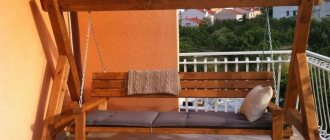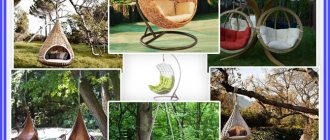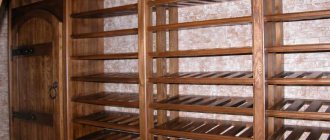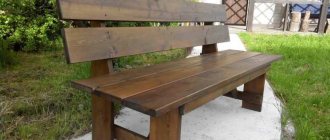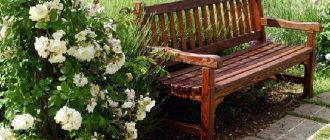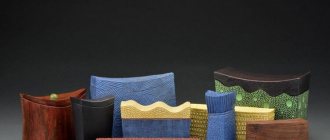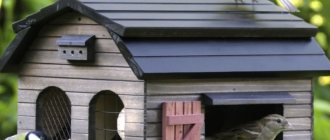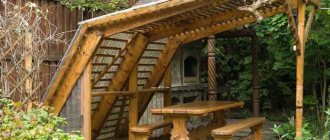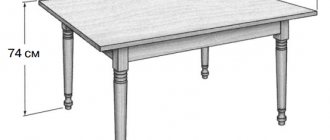Arriving at their summer cottage, many expect to relax, unwind and have a good time. In order to turn these plans into reality, care must be taken to create the appropriate conditions. It is not enough to simply install a few benches.
You can make an attractive and original corner in which you can relax, enjoy the surrounding nature and the results of your own labor.
Types of benches
There are many types of benches. The master brings something special and unusual to the appearance of this simple element for the garden. However, all models can be divided according to some common characteristics.
Benches without backrest
This type is considered the simplest, as it consists only of a seat and several supports. Only this can all be implemented in different ways.
- We have before us a reliable, but not very attractive solution. However, the creator of this design still provided for a certain asymmetry - one edge of the seat protrudes beyond the legs, and the other is level with them. The bench is made of thick integrated boards and laminated veneer lumber. Externally, the material is roughly processed. This bench is suitable for many rustic styles, such as American country.
Simple wooden bench without back
- This bench is made of wood and concrete was used for the supports. Such composite structures look good in many landscape design styles, for example, high-tech, minimalism or loft. Concrete parts have clear geometric shapes. Against their background, the varnished board contrasts perfectly and looks very advantageous. Such a bench will also be very stable, but extremely heavy - moving it to a new place will be difficult.
Concrete wooden bench legs
- The back of this model is purely symbolic, so we will assume that it does not exist at all. It is not clear whether it will be comfortable, but it definitely looks impressive. Frame type construction. The basis was steel strips, which were looped and sheathed with a narrow lath. For stability at the bottom, additional stops are welded from a steel corner.
Outdoor benches made of metal and wood
A common disadvantage of benches without a back is the inability to completely relax while resting. You have to either keep your back tense, or create support with your hands on the seat or legs.
Benches with wooden backs
These models have a complicated structure, but they are more pleasant to relax on.
- A master of his craft clearly put a lot of effort into this model. The building material used was wooden beams, unprocessed branches and boards, which were given a rounded shape. All lumber is treated to appear aged and untreated by man. The absence of right angles and straight lines hints at unity with nature. Even the seat itself is slightly rounded inward along a wide radius.
Wooden bench with backrest for 2 people
- To achieve an aged effect, the wood is brushed. All soft fibers are removed from the surface of the material. This reveals its internal structure. A beautiful relief remains, which is further emphasized when processed with paints and varnishes or during firing. On this bench there are brushed boards in a composition with raw cuts of the trunk.
A trunk cut was used for the backrest
- Such designs are not suitable for every garden. Some styles value lightness and grace. An example of such a shop is shown in the photo below. The bench is clearly of factory origin, but if you have the right tools, you can do something like this yourself. In the photo there is clearly a lack of flowering vegetation around the bench.
Lightweight bench made of treated lumber
Assembly of such benches is also not the most difficult. Next, drawings will be presented and methods for their implementation will be described.
Bench with table
Such seats are installed mainly on terraces (read the article about arranging a terrace in a dacha), verandas and gazebos. The combination of furniture pieces forms the finished dining area.
- The photo shows an option for children. The tabletop is mounted on trusses with widely spaced legs. Crossbars are installed across them, to which the suspended bench seats are attached. Such a bench does not require a lot of material; its design is quite simple. In this case, the parts are securely connected to each other.
Wooden garden tables and benches for children
- These benches will withstand more serious loads, since they are not transferred to the table body, as in the previous case - the base under the structure is loaded. In fact, we see three separate objects connected at the bottom by a common strap. This solution gives stability to the thin legs of the bench. The seats and table top are made in an interesting way - a neat frame is formed from the board, the inside of which is filled with flooring. It looks very neat and beautiful.
How to make a wooden bench with a table for 4 adults
- The next model is complicated by the fact that it has backrests. The seats are held in place by common jumpers. It will be awkward to sit down and leave such a table. And if you consider that a backrest has also been added, then the options for this are even more limited.
These wooden benches have comfortable backs
. In general, the inconvenience of placement is a drawback of all such structures. Different people have their own sizes, so hosting guests at such a table can be a bad decision. Also, these beautiful wooden benches require a large and flat area for installation, so they are rarely placed on the ground.
Bench-sofa
This is the same bench with a back, but there are design differences. Firstly, soft pillows are always laid on top of the seat and under the back, secondly, they are made lower and are not placed in front of the dining tables, and thirdly, the seat is made deeper so that you can literally lounge on it.
- Like the previous option, these benches, due to their large dimensions, are installed on spacious terraces. This sofa is made from sanded and varnished boards. The pillows are stuffed with several layers of foam rubber and have removable covers so they can be washed (read the article on how to make pillows for garden furniture).
Bench-sofa corner
- Such structures usually have angular shapes, so processed timber of the correct cross-section is used for their manufacture. They do not differ in elegant shapes, so assembly will not be difficult - it is enough to build a strong frame, which is then covered with boards. These sofas look good in new style gardens.
Sofa with closed sides
- Old pallets are suitable as the main material for such a sofa - their shape and design correspond to the style of similar structures. Furniture made from pallets is a godsend for a loft-style garden. This material is inexpensive and very durable.
Location
The first problem that needs to be solved is choosing a location for the bench. It affects the material of the structure. For example, for an old garden with large branchy trees, wood products are suitable; for a small area not heavily planted with trees and shrubs, small openwork structures are recommended.
If you look online for examples of photos of benches in the country, you will see that they are often an integral part of gazebos, verandas and summer areas. If you are planning to do something similar, then make sure that all the details are made in the general style.
Choose a place for the bench so that it offers a pleasant view. It’s unlikely that you’ll want to admire your neighbors’ fence or the walls of your barn.
It is advisable to choose places in front of lakes or rivers, flower beds, etc. The main thing is that the surrounding objects attract and please the eye, help you relax and put you in a positive mood.
It is advisable that the bench be located in the shade. It is placed under the crowns of large trees or under canopies. Remember that it acts as a place for rest and relaxation.
You can put benches next to the beds. There are several advantages here. Firstly, the owners of the site will be able to monitor the growth of the crop. Secondly, the bench is suitable for taking a few minutes’ rest from physical labor (digging, watering, harvesting).
Don't forget about decorative decorations. Have you made a simple bench with your own hands? Place flowering shrubs around it. Flower beds are also suitable for decoration. They are placed on a raised platform or a special platform is created from bricks, tiles or logs.
Materials for making benches
We have already seen what materials are used for garden benches, but there are no specifics yet. In this chapter we will analyze everything point by point.
| Material, photo: | Description: |
Treated lumber | Available in the form of slats, boards and beams. All this is used in structures of different sizes and complexity. Selecting the type of wood, the correct cross-section of parts and proper processing of materials allows you to create strong benches. Glued and bent wood is a separate category. This material is incredibly durable, moisture resistant, and does not deform due to changes in humidity. |
Benches for summer cottages made of metal and wood | Wood combines beautifully with metal, which is known for its durability. The frame of the structure is most often made of iron, which is covered with wood, but there is another option when only metal inserts are used as decoration of the product. The structures are assembled from various parts. Are used:
Benches with forged inserts look very nice (options of forged garden furniture are presented in our article). |
Block piece material | The base of the bench can be built of brick, or these hollow concrete blocks. The last option is considered the easiest to implement. In the photo on the left you can see that the blocks are simply folded into certain shapes, and the timber is inserted into the voids in them. To prevent the bench from being flimsy, it is better to tie the materials together. The brick base is placed on the mortar - it will be very reliable. This bench will be stationary. |
Hand-cut bench made from solid logs | Uncut wood is also often used for benches. These include driftwood, branches, and logs. Log models are extremely difficult to make, since you have to work with solid wood, precisely adjusting the gaps of the parts. It is difficult to do this without proper experience. Such benches are suitable for many national styles of Europe and Russia (you can see options for furniture made from logs at the link). |
Pallet bench | We included furniture made from pallets in a separate category, since they are used containers and are already put together according to a certain principle. On our website there is a separate article on garden furniture made from pallets, be sure to read it. |
The work can also use concrete, natural stone, metal mesh, hemp, logs and much, much more. Products made from other items look interesting. An example of this is shown in the following photo.
Bench supports from cart wheels
Product Features
Regardless of the location of the bench, it must meet a number of basic requirements:
- be stable and have a strong construction;
- a comfortable bench should fit organically into the surrounding landscape.
A homemade bench may have a non-standard appearance. At the same time, it should be safe and comfortable for relaxation.
For this reason, experts recommend a responsible approach to the choice of material, processing of parts and providing products with a backrest. To place a garden bench, it is wise to choose a quiet and shady corner next to a beautiful flower garden or a cozy gazebo.
Do-it-yourself benches for a summer cottage made of wood
Now let's talk a little about making such pieces of furniture. Let's look at two options.
Wooden bench without backrest
Basic parts of a simple form.
For work you will need the following materials:
- 4 boards with a section of 80*30 mm, length 1500 mm
- One beam with a cross section of 70*40 mm of the same length.
- Two 40 cm pieces of 40*30 mm timber.
- Glued board measuring 1000*1000 mm or larger, 40 mm thick - shaped supports will be cut from it.
Finished drawing of a wooden bench
All parts will be fastened with self-tapping screws.
- To begin with, a template is made from a sheet of cardboard that follows the shape of the legs of the bench (you can develop your own design).
- The shield is marked on it - two identical parts are needed.
- The edges of the workpieces are sanded and rounded with a milling cutter to add beauty.
- Next, a rectangular hole with a cross section of 70*40 mm is made in them, and the corresponding beam is hammered into them. The parts fit tightly and can additionally be joined with PVA glue.
- A short block of wood is placed on top of the posts to create a wider support for the flooring.
- The boards for the seat are mounted with a certain indentation.
Wooden bench with backrest
Again, the complexity of the job will depend on the type of structure.
Drawing of a wooden bench with dimensions
Do-it-yourself wooden bench drawings
A very clear and fairly simple plan. It indicates the dimensions of all parts and shows their shape. Despite the fact that the structure has a curved appearance, it is assembled from a rectangular beam and slats. There is not enough information on the type of fastener, its dimensions and installation points, although all this can be modified yourself.
Bolted connections will hold the best quality. Options for dowels, grooves and ridges are also reliable, but without being a carpenter, you won’t be able to make them well. Also, feel free to use stainless steel self-tapping screws - they are durable and not subject to corrosion.
Assembly methods
Various types of fasteners are used to secure parts to each other:
- Self-tapping screws for wood. They differ from self-tapping screws for metal with a wider thread pitch. Installed in pre-drilled holes to prevent wood from splitting. The length is selected on the basis that the hardware should fit into the attached part by 1/3 of its thickness.
- Bolts. Connect two boards through a through hole. They are tightened with nuts and wide washers to prevent the wood from pressing through at the fastening point.
- Nails. Traditional fasteners for wooden structures. To avoid cracking, the rod is trimmed with pliers or filed with a file. A blunt point does not push apart, but breaks the fibers, thereby preventing the formation of cracks.
- Staples. They are U-shaped rods driven into 2 adjacent parts.
- Overlays. Fastening with perforated or serrated plates, corners, and brackets is widely used for furniture manufacturing and construction.
For external work, only corrosion-resistant fasteners are used - stainless, brass, galvanized or oxidized. It is not advisable to use black, it rusts quickly.
In carpentry, you can do without hardware at all and make connections on dowels. Wooden cylinders with a diameter of 6-10 mm are placed on glue in the prepared holes and keep the parts from moving. The adhesive composition must be intended for outdoor use.
A popular type of joining wood structures is mortise. A groove is made in one part, and a tenon is formed in the other. During installation, glue is used, and the joint is strengthened with nails or self-tapping screws.
How to process wood
Since many tree species are not “friendly” with a humid environment that causes rot, products used outdoors must be carefully processed. Such protection will also protect against exposure to ultraviolet radiation, from which the material can fade and change its true color. Finishing is also done to transform the appearance of the wood. To do this, take the following compositions:
- Colored opaque paints that completely hide the wood texture. Various compositions are used, from which we want to highlight acrylic-based options. This material creates a durable and long-lasting coating. It comes in different colors. The material hardens in the form of a film.
Opaque paints
- This material looks like varnish, but it is not. In contrast, a vapor-proof film is not created on the surface - the wood still breathes. Azure saturates the wood with deep tones. It penetrates its structure and reliably protects it from moisture and ultraviolet radiation.
Azure
- Varnishes create a film on the surface and prevent water from getting under it. This material can be transparent or colored. For outdoor use, it is best to choose the option for yachts, as it will last a very long time and create an even, glossy finish that shines very beautifully in the sun. Clear varnishes are used in combination with various impregnations, for example, stain.
Wood varnish
- One of the oldest and best ways to protect wood is to coat it with oils. This material penetrates deep into the wood structure, giving it water-repellent properties and a beautiful deep shade. Oils are used to treat decking near swimming pools and even on piers, which indicates a high degree of protection (the choice of oil for garden furniture is discussed in the article).
Wood oil
Decorative and protective treatment
Wood is the most common material for garden furniture. It is easy to process, light and durable. In terms of tactile sensations, the surface of wood is much more comfortable than metal or concrete.
As a rule, wood is treated with impregnations with an antiseptic effect, and then covered with decorative compounds - waterproof paints, enamels for exterior use, stain, yacht varnish, wax, oil. It must be taken into account that natural material does not like ultraviolet radiation and reacts to sunlight with photodestruction. Therefore, choose paints and varnishes with a UV protective component.
If you like old things with their own history, even a new bench can be turned into an antique artifact. For this purpose, artificial aging, or brushing, is used.
Soft fibers are removed from the surface of the wood with a stiff brush, and the exposed structure is emphasized with paints and varnishes. The resulting effect is very picturesque. An aged bench looks harmonious against a background of greenery and grass.
Blowtorch firing is used as a decorative and protective finish. As a result of heat treatment, wood becomes denser, increasing its resistance to moisture, rotting and mechanical damage.
Additional functionality – awnings over benches
If there are no shady areas on the site, then an additional canopy can be provided for protection from the sun. Let's look at several options for its implementation.
The canopy can be installed separately or made part of the structure, as in the presented photo. Here we see 4 racks made of timber, on which the top trim is made. The roof is formed by boards installed on edge - the classic form of a pergola. Lath trellises were added to the sides of the structure. All this will become a reliable basis for climbing plants, which after a while will provide beautiful and cool shade.
Pergola canopy
Installing a large canopy can be made from a simple bench into a swing. This functionality will be appreciated by both adults and children.
Bench with a wooden canopy in the form of a swing
Blueprints
When planning the manufacture of a garden bench, you need to think about the appearance of the product and draw a detailed drawing. Drawings for making benches are easy to find in finished form.
A detailed drawing will allow you to correctly calculate the consumption of materials and think through the technology of work.
The size of the product is calculated based on the need for seating. It is not advisable to make a small bench for a summer cottage where a large family is relaxing.
For work, you can use the standard overall dimensions of a garden bench.
To comfortably accommodate three adults, the seats are 150 cm long. The width of the seat is usually 40 cm. The height of the bench is 45 cm from the ground, while the height of the back is 90 cm.
The bench should be installed at an angle of about 20 degrees, this will make using it more convenient.
At the planning stage, you need to think about ways to attach the backrest.
Note!
- Do-it-yourself wardrobe: a review of ways and methods on how to build a stylish and original wardrobe (video and 145 photos)
Do-it-yourself furniture restoration - removing chips and scratches, restoring surfaces. Instructions with photos and video tips
DIY ottoman: how to make it at home. The best ideas, master classes. Photo + video review of beautiful ottomans
Precautionary measures
Once the choice of design type has been made, it should be taken into account that among the entire variety of various types of benches and benches, there are a number of general safety rules:
- All materials used during assembly, regardless of metal, wood, plastic, must have a perfectly smooth surface to avoid splinters, burrs, etc., getting into the skin.
- It is better to refrain from having sharp corners and protruding elements in the design.
- The height of the seat should be safe in case a child falls.
Workplace
In order for the selected design to turn out as intended, the work site must be properly prepared:
- For ease of marking and cutting, a wide platform is needed that does not restrict movement.
- Lighting must be sufficient.
- It is necessary to provide access to the electrical network.
- It is advisable to have a vice or clamps.
For garden
You can make a good DIY wooden bench even from ordinary branches, you just need to properly process and arrange them. This design can make a personal plot look fabulous and quite charming due to its unusualness and creativity.
Even the oldest branches will fit very harmoniously into the appearance; they need to be secured well, because the product should not serve only a decorative function. Using your imagination, you can create a unique composition and a rather cozy and stylish thing.
Useful tips
To make garden benches, you should use high-quality material. The service life of the product will be extended by treating wooden and metal elements with special primers, paint and varnish.
The surfaces of the parts should not have irregularities, burrs, or protruding sharp parts of fasteners.
To install the bench, you need a flat area without stumps, holes and stones.
It is recommended to make the back and seat from separate parts, leaving gaps between them for ventilation.
The bench should not be placed under fruit trees. Falling fruit will quickly ruin its appearance.
